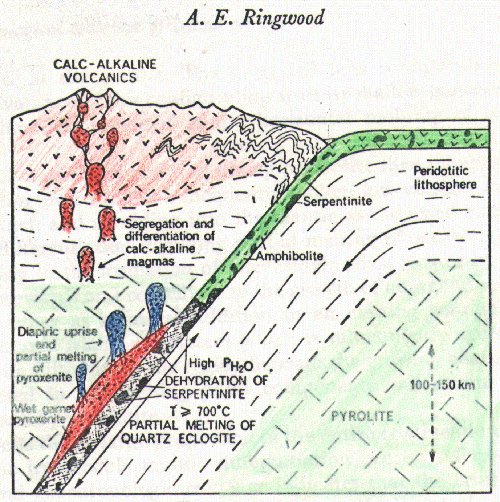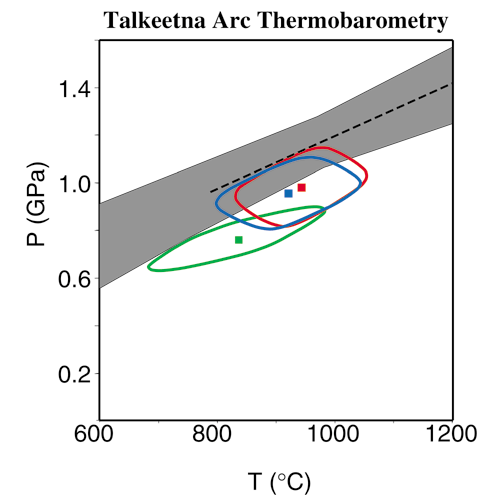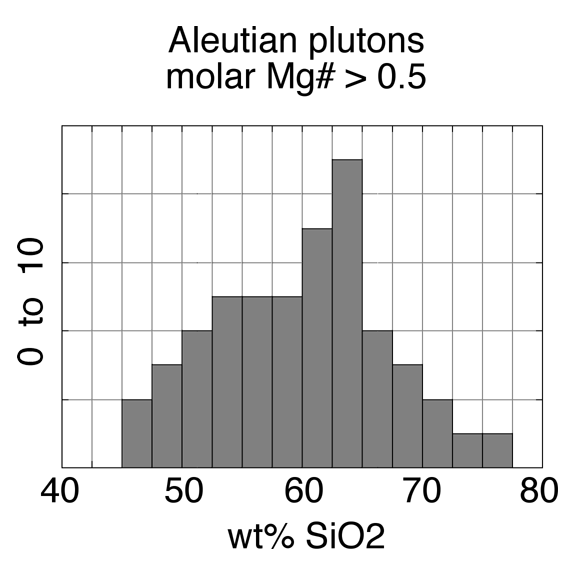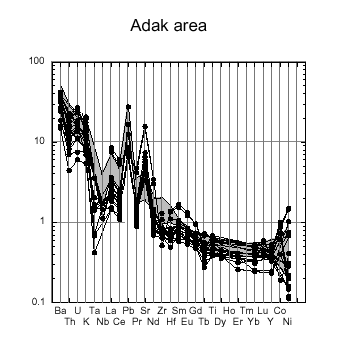|
|
 |
Arc magmatism and Continental Genesis
- Trace element similarities between arc magmas and continental crust suggest that a large proportion of continental crust was formed via processes similar to present-day arc magmatism. However, most arc magmas are basaltic whereas the continental crust is andesitic. How can this paradox be resolved? Among several options, we have worked on two, potentially complementary explanations.
- At some times and places, arc magmas are predominantly andesitic. Evidence for this comes from primitive andesite magmas in selected arcs. The only intra-oceanic arc with abundant primitive andesites is the Aleutians. Aleutian primitive andesites have trace element contents strikingly similar to continental crust. Geochemical evidence strongly suggests that partial melts of subducting eclogite form an important component of Aleutian primitive andesites. Fractionation of ultramafic cumulates from such magmas can produce crust with an andesitic bulk composition like continental crust. Perhaps such magmatic processes were more common during hot subduction in the Archean.
- It has been proposed that dense, mafic to ultramafic cumulates at the base of the crust are gravitationally unstable, and eventually sink into less dense, underlying mantle. Such "delamination" of cumulates could, potentially, convert basaltic arc crust into andesitic continental crust. However, it could also occur if the crust initially had a primitive andesite composition. We recently made thermodynamic calculations to determine the PT conditions under which likely lower crustal rocks are denser than the underlying mantle, and dynamic calculations to estimate the rate of convective instability arising from this density inversion. We found that likely arc cumulates are denser than the upper mantle over a relatively wide range of PT conditions likely near the arc Moho, and that instability times of 1 to 10 Ma are likely when dense cumulate layers exceed 1 km in thickness.
- Pyroxenites at the base of arc crust, formed at about 1 GPa, have low Al contents. An experimental study shows that H2O contents of a few wt% are needed to supress plagioclase stability and crystallize pyroxenites from arc magmas. The low Al pyroxenite compositions observed at the base of arc sections are not produced by crystallization of a tholeiitic arc basalt at 1.2 GPa, but are produced by crystallization of primitive arc andesite at the same pressure.in a variety of cratonic mantle samples to constrain their origin, and study of xenoliths from a new locality that we discovered in East Greenland in 2000.in a variety of cratonic mantle samples to constrain their origin, and study of xenoliths from a new locality that we discovered in East Greenland in 2000.
- Arc thermal structure: A variety of evidence suggests that partial melting of subducted sediments and/or basalts is common in arcs. In some arcs, this is mainly trace element evidence, such as high Th/La, and is correlated with the flux of subducted sediments. In other arcs, major and trace element evidence suggest a large role for partial melting of subducted basalt in eclogite facies. In the Aleutians, along strike variation suggests an important sediment melt component in the east, and an important eclogite melt component in the west. However, most thermal models of subduction rule out partial melting of subducted sediment and basalt. This motivates a critical look at subduction thermal models. In fact, all thermal models predict temperatures less than 600°C at 1 GPa, whereas metamorphic closure temperatures from the base of exposed arc sections are ~ 1000°C at 1 GPa. Similarly, thermal models predict temperatures less than 800°C at 1.5 GPa, whereas estimated conditions for equilibration of primitive arc magmas with mantle peridotite are ~ 1300°C at 1.2 to 1.5 GPa. Seismic tomography is consistent with the petrological PT estimates, suggesting that melt is present in the mantle up to Moho depths over broad regions beneath arcs. Our current research focuses on explaining these high temperatures as a consequence of thermal convection in the mantle wedge. Simple scaling relations predict that the mantle will convect 10x faster than plate subduction rates if the viscosity is less than ~ 1019 Pa s. Such low viscosities have not previously been incorporated into thermal models for subduction zones, but are well within the range of possible asthenospheric viscosities, particularly if H2O fugacity is high and/or melt is present.
- Composition and dynamics of exposed, arc lower crust: We are working on one of two exposed arc sections in the world, the Talkeetna section in south central Alaska, in a Continental Dynamics project with 10 PI's. This broad study will investigate the major and trace element contents of arc lower crust, building on the earlier estimates of DeBari, Sleep, Coleman, Burns, and their co-workers in the late '80's. We will determine the first U/Pb zircon ages from this section, and combine them with garnet-rock Sm/Nd and Lu/Hf isochrons, Ar/Ar geochronology, U-Th-He dating, metamorphic petrology, and microstructural analysis, in order to characterize the thermal and dynamic history of the crust and uppermost mantle. Did garnet grow in gabbros at the base of the crustal section, rendering cumulate gabbros denser than the underlying mantle, during arc magmatism while the mantle was hot and relatively invisid? Do geochemical data support the hypothesis that large quantities of garnet gabbro have been removed by convective instability? Or did garnet grow during rapid cooling after cessation of arc magmatism? How was strain partitioned between (highly deformed) upper mantle peridotites and the overlying crust? Are felsic plutonic rocks generally younger than underlying gabbros? Did subsidence and resulting heating of mafic mid- and lower-crustal lithologies lead to partial melting? Or did the felsic rocks form as a result of crystal fractionation processes?
- Generation of primitive andesites in the western Aleutian arc: We have several proposals to dredge young, submarine volcanoes in the western part of the Aleutian arc, where magmas are dominantly high Mg# andesites, but there are few sub-aerial volcanoes, and these have been sparsely sampled. Dredging will yield young volcanic rocks, including glass inclusions, which can be used to determine magmatic volatile contents and temperatures, whether basaltic and andesitic primary magmas are coeval, and whether the mantle source of basaltic magmas can be shown to be isotopically distinct from the mantle source of primitive andesitic magmas.
- Arc lower crust in Central America: With Steve Holbrook and others, we have proposed to do a refraction survey of the Central American arc from southern Nicaragua to western Panama. Lavas in this area range from tholeiitic basalts in the NW to calc-alkaline andesites in the SE. Is this variation due to differences in primary magmas, or to differences in crustal differentiation?
|
|



